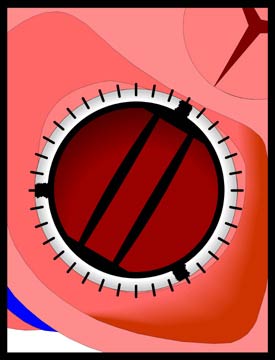| Valve and Conduit Replacements |
|
|
 |
|
Mitral Valve Replacement
Wherever possible, mitral valve repair is preferred to valve replacement. In childhood cases of Mitral Stenosis where valve replacement is deemed necessary, the procedure is deferred as long as possible to allow implantation of larger valves in growing children.
The replacement mitral valve may either be mechanical (e.g. St. Jude mitral valve - shown in illustration) or bioprosthetic (homograft (human) or allograft (animal)). If a mechanical valve is used, permanent anticoagulation with coumadin is necessary.
Risks associated with prosthetic valves include the development of valve-related endocarditis (valvular infection), the deterioration of bioprostheses (human or animal valves), embolism formation, and, in the case of mechanical valves, thrombosis (clots).
Implanted valves will eventually need to be repaired or replaced. Most surgically implanted prosthetic valves will last 10-20 years before they wear out, become obstructed, or lose efficiency. |
|